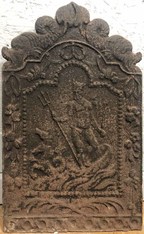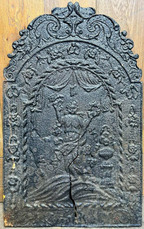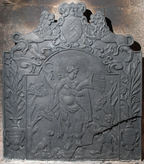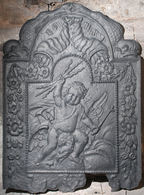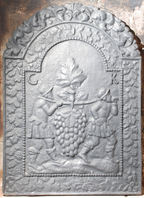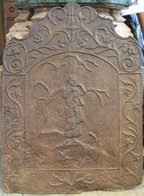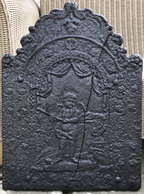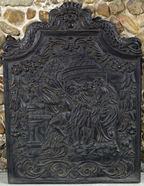-
1224
Description: Arched rectangular shaped central panel with canted, concave top corners and bead edging; naked, crowned figure of Neptune holding a trident in his right hand, standing amid waves and with two hippocampi to his right; same-shaped border with fillet edging and suspended ribbons with floral bunches; at base, symmetrical reeds tied with ribbon; base panel with nine linked rings; symmetrical serpents on top.
Notes: Other firebacks have the same distinctive central panel and border shape, suggesting the same pattern maker.
- Decoration tags:
- 'Dutch' (shape)
- fillet (edging)
- whole carved pattern
- pictorial
- mythological
- animals
- objects
Manufactured: in the early-18th century possibly in the Weald area of England.
Current location: not known.
- Attached to series:
- Mayfield 'Dutch' series
- British 'Dutch' style firebacks
-
1130
Description: Arched rectangular central panel with helical ribbon edging; pictorial image of a partially clothed female figure, holding an upraised wreath in her left hand and a garland in her right hand, standing on a ground, with a gadrooned vase containing flowers and leaves to the right and, above, swagged drapery; arched rectangular fillet border with descending leaves and flowers suspended from a wreath, top centre, and a wreath in each top corner; on top, mirrored swirled fronds terminating in the heads of sea monsters; bottom, vestiges of SHR monogram otherwise all decoration obliterated by fire damage.
Notes: The figure is an allegorical representation of Agriculture, one of the Iconologia originally published by Cesare Ripa in 1613.
Copies of this fireback are known.
Inscription: SHR
- Decoration tags:
- 'Dutch' (shape)
- fillet (edging)
- whole carved pattern
- allegorical
- text
- humans
- plants
- objects
Manufactured: in the early-18th century in England.
Current location: Authentic Reclamation, Lymden Lane, Ticehurst, East Sussex, England.
- Attached to series:
- Agriculture firebacks
- SHR series
- British 'Dutch' style firebacks
-
1297
Description: Arched rectangular shaped central panel with bead-on-fillet edging; a peacock, facing right, standing on a plinth, with foliage to the left and clouds above; arched rectangular shaped border with fillet edging, symmetrical floral fronds descending from a scallop shell, top centre, with a scallop shell inside each shoulder; at base, detail mostly obscured by corrosion but the numerals '17 24' are faintly visible in the bottom corners; on top, a pair of mirrored, stylised sea serpents with a central arrangement of foliage.
Notes: The image of the peacock may be an adaptation of an engraving (1654-62) by Wenceslaus Hollar, after Francis Barlow, in which a peacock also stands on a plinth. The small size of this fireback makes it likely that it was intended to be fixed to the back of a grate. A copy of a fireback of this design features in Gleanings from Old English Firesides by Arthur Todhunter.
Copies of this fireback are known.
Inscription: 17 24
- Decoration tags:
- 'Dutch' (shape)
- fillet (edging)
- whole carved pattern
- animals
Manufactured: in 1724 in England.
Current location: Authentic Reclamation, Lymden Lane, Ticehurst, East Sussex, England.
Citation: Todhunter, A., c.1910, Gleanings from Old English Firesides (New York, Arthur Todhunter), p. 3.
- Attached to series:
- British 'Dutch' style firebacks
- 1724 series
-
701
Description: Arched, rectangular central panel with fillet edging; figure of Abundance holding a sickle and a Horn of Plenty, a child, also holding a sickle, to the right, a seated dog to the left, framed by trees; fillet-edged border with a plant pot each side, lilies issuing therefrom; above an oval shield of arms, a grotesque face above, supported by two lions.
Notes: Abundance was one of many allegorical figures to feature in the Iconologia, first published by Cesare Ripa in 1593. The style of the fireback derives from those produced in the Siegenland of NW Germany for the Dutch market, but this example may be a pastiche produced for the French market.
Copies of this fireback are known.
- Decoration tags:
- 'Dutch' (shape)
- fillet (edging)
- whole carved pattern
- pictorial
- allegorical
- armorial
- animals
- humans
- plants
Manufactured: in the late-17th to early-18th century possibly in the Lorraine area of France.
Current location: Tiverton Castle, Tiverton, Devon, England.
- Attached to series:
- 'Dutch' Miscellaneous Firebacks
-
704
Description: Arched rectangular central panel with bead edging; pictorial figure of a winged child holding a thunderbolt in his right hand and a sceptre in his left hand, on a ground of clouds; arched rectangular border with astragal and cavetto moulded edging; two cornucopiae, flowers and leaves tumbling from them and hanging suspended down the sides; on top, two sea serpents.
Notes: The figure is of Zeus/Jupiter as a child.
Copies of this fireback are known.
Inscription: 16 [...]
- Decoration tags:
- 'Dutch' (shape)
- cavetto (edging)
- whole carved pattern
- pictorial
- mythological
- text
- humans
Manufactured: in the mid- to late-17th century in the Siegerland area of Germany.
Current location: Tiverton Castle, Tiverton, Devon, England.
- Attached to series:
- 'Dutch' Miscellaneous Firebacks
-
706
Description: Arched rectangular central panel, with bead edging; pictorial, two men in 17th century dress, on a ground, carrying a huge bunch of grapes slung from a pole between them, behind are vine leaves; the initials located below the top corners; arched rectangular border, fillet edging, containing vine leaves and grapes; above, symmetrical swirling foliage.
Notes: The scene, drawn from the Old Testament, represents Joshua and Caleb carrying the bunch of grapes from the valley of Eshcol in the land of Canaan, back to Moses and the children of Israel (Numbers 13: 23-4); a small number of firebacks bear the initials, GK; it is not known to whom they refer, but dated examples are of 1700.
Copies of this fireback are known.
Inscription: G K
Manufactured: in 1700 in the Siegerland area of Germany.
Current location: Tiverton Castle, Tiverton, Devon, England.
- Attached to series:
- 'Dutch' GK series
- Old Testament & Apocrypha firebacks
- Joshua and Caleb firebacks
-
709
Description: Arched central panel with fillet edging; figure in classical dress standing on a mound in front of a leafless tree; u; ninterrupted side and bottom border with straight fillet edges; at sides, mirrored low-relief undulating tendril design; at bottom, central leaf design; on top, central plume with hanging flower, between mirrored low-relief foliate swirls.
Notes: The figure is probably an allegory of Humility. Another example of this fireback bears the date 1746.
- Decoration tags:
- 'Dutch' (shape)
- fillet (edging)
- whole carved pattern
- pictorial
- allegorical
- humans
- plants
Manufactured: in the mid-18th century .
Current location: not known.
- Attached to series:
- 'Dutch' Miscellaneous Firebacks
-
1263
Description: Arched rectangular shaped central panel with hollow bead edging; a putto, its head inclined to its left, standing on a platform, holding a wand in its right hand and a branch in its left hand, a flower in a pot is on each side, and above, swagged drapery; arched rectangular shaped border with fillet edging; swirled flowers and tendrils symmetrically arranged, with SHR monogram at centre bottom; two mirrored stylised sea serpents on top; to each side a vertical extension with bead edging, of the same decoration as the side borders.
Notes: The figure depicted is probably emblematic although the meaning has yet to be determined. The frame of the central panel and the enclosing border are identical to those noted on another fireback displaying a figure of Pluto (see fireback no. 164). This may be an example of an image from one casting being superimposed within the frame of an earlier fireback. The border is identical to that seen on fireback no. 1220.
Inscription: SHR
- Decoration tags:
- 'Dutch' (shape)
- bead (edging)
- whole carved pattern
- extension panels
- pictorial
- allegorical
- monogram
- text
- humans
- plants
- objects
Manufactured: in the early-18th century in England.
Current location: not known.
- Attached to series:
- British 'Dutch' style firebacks
-
716
Description: Cavetto canted rectangular central panel with ovolo-moulded edging, enclosing a pictorial scene of a naked female seated at a fountain on the left, with two clothed males to her right; behind, a part of a domed brick building with the inscription around the top of the wall; enclosing the scene, twin floral festoons suspended from top centre; on top, a central crown between two descending dolphins.
Notes: The scene depicts the Apocryphal story of Susanna and the Elders.
Copies of this fireback are known.
Inscription: SVSANA
- Decoration tags:
- 'Dutch' (shape)
- ovolo (edging)
- whole carved pattern
- pictorial
- biblical
- architectural
- humans
Manufactured: in the late-17th to early-18th century in Germany.
Current location: not known.
-
717
Description: Arched rectangular central panel with bead-on-fillet edging; femal figure holding scales in her right hand and a sword in her left hand, foliage and clouds behind; arched rectangular border with fillet edging; from a central bow with three tassels at the top, two suspended festoons of flowers, each running through a ring under the top corners, and continuing along the bottom; on top, a central cartouche between mirrored foliate scrolls.
Notes: The female is an allegorical representation of Justice.
Copies of this fireback are known.
- Decoration tags:
- 'Dutch' (shape)
- fillet (edging)
- whole carved pattern
- pictorial
- allegorical
- humans
Manufactured: in the early-18th century in England.
Current location: not known.
- Attached to series:
- British 'Dutch' style firebacks
